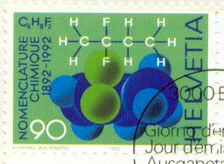Development
of Systematic
Names for the Simple Alkanes
(I compiled this page partly
because I was
embarrassed in class by not knowing their etymology.
It is not a crucial part of Chem 125 and is
presented for your
amusement and enrichment.)
The
nomenclature of organic chemistry
is both a tool and a symbol of the chemist's mastery over molecules
of modest size. Lavoisier set a high standard in 1789 when he
suggested that a compound's name should clearly describe its nature.
Of course one had to know something of its nature before being able
to give it an appropriate name, and the nature had to be simple
enough to name. Otherwise only a nickname was possible, perhaps one
describing its source, or color, or use. Such a name might be useful,
unambiguous, and unique, but it could never be systematic in a way
that would allow it to conjure up the structure for a chemist who had
not previously encountered it. The complexity of very large organic
molecules, and practically all large biochemical molecules, prevents
their nomenclature from becoming usefully systematic and encourages
the use of nicknames, leaving communication of structural detail to
pictures. For most large molecules the power of organic nomenclature
for aiding thought and communication remains a dream.
|
Organic
structure was a meaningless concept until 1858 when Couper and Kekulé proposed valence. Over the
next three decades a large number of constitutional structures were
determined, and there arose a clear need for a structure-based system
of nomenclature. In 1892 the International Congress
of Chemists, meeting in Geneva, approved a report on the subject that
had been developed over the three years since the previous meeting of
the Congress in Paris. This "Geneva Nomenclature"
contained the core of the system that, as IUPAC nomenclature
(International Union of Pure and Applied Chemistry), remains in use
after more than 100 years and is constantly being updated to deal with
the latest challenges in structural chemistry. Much of the financial
support for this effort is supplied by industries affected by the
patent and legal implications of how we name molecules.
|

|
The Geneva system is
based on
identifying hydrocarbon chains, most of which are named
systematically with a Greek numerical prefix
denoting the
number of carbons and the suffix -ane
if they contain
no multiple bonds. It is instructive to see how the unsystematic
names for the simplest chains developed, because it underlines how
small the community of academic chemists was, and it reinforces what
we know about the development of organic chemistry. In chemical as in
human families, names provide a link to our heritage.
Two ancient
word roots entered into
the naming of simple hydrocarbons. One was HYLE
from the Greek υλη
(üleh,
where the ü is
pronounced as in German or as in "lune" in French) meaning wood or matter. Aristotle and
other Greek philosophers had used υλη
πρωτυ
(üleh
proteh) to
denote the fundamental matter of the universe from which all things
are made. When in 1815 William Prout
had the idea that all elements were composed of hydrogen atoms, he followed
the Greek lead by calling this atom protyle.
The other is ETHER
the root of
which (αιθο,
etho) means to shine and was related in the ancient
tongues to
fair weather, clear sky, and the space beyond the clouds. Already in
the 1700s it was firmly associated with the colorless, light,
volatile liquid formed by treating alcohol with acid. "The subtile
fluid, prepared from vinous spirits with the vitriolic acid, called
by the chemists æther..." (1757) was of course what we call
diethyl ether. As additional clear, volatile liquids were discovered,
they also came to be called ethers.
|
The
first 19th Century coinage related to the simple hydrocarbons arose in
1826 when Michel Eugène Chevreul, who was purifying fatty
acids (and would propose using melting point as a criterion of purity)
gave the name BUTYRIC acid to the acid from rancid
butter, using the Latin root butyrum for butter and
Lavoisier's -ic suffix to denote acid.
|

|
|
Michel
Chevreul
(1786-1889)
Chevreul also discovered and named
creatine,
which has been faddish as a body-building
dietary supplement - Note that he lived
to the age of 103, presumably without
consuming any dietary supplements.
Chevreul is said to be the
only centennarian scientist
who was born before 1864.
|
In 1832, when
Liebig
and Wöhler discovered
the benzoyl radical, they proposed the suffix -YL for
naming
radicals to evoke the sense of ultimate matter or hyle.
The
German pronunciation of the suffix is much closer to the Greek
"üleh" than is the American "uhl" or the British "isle".
In 1834
Liebig proposed that ether
was based on the radical he called ETHYL, using as
root the
word ether and the suffix -yl.
Remember that the
archetypal ether was diethyl ether
In the next
year, 1835, Dumas
proposed the METHYLENE radical (CH2)
from Greek μεθυ
(methü) for wine
and hyle for wood (hyle's other meaning), with -ene,
a
Greek feminine
patronymic
tossed in to give
the meaning "daughter of the spirit of wood" (remember that the
formula of wood alcohol is CH3OH or for Dumas
CH2
•H2O).
By
1840 the French chemist Regnault was already calling the
CH3 radical METHYL, where
the meth part
comes from Dumas's methylene and the yl
does double
duty representing both the yl in methylene,
where it
means wood, and the -yl radical suffix, where it
means
matter.
In 1847 Dumas
named the three-carbon
acid PROPIONIC, from Greek proto
(πρωτο,
first) and pion (πιον,
fat) again with the Lavoisier -ic suffix. The
physical
properties of the smaller acids, formic (from Latin formica,
ant) and acetic (from Latin acetum,
vinegar) were not
considered fat-like. By 1850 the three-carbon radical was being
referred to as PROPYL. (Click for
Dumas's
rationale.)
The name
ether was being used widely
for clear, volatile liquids, so in 1848 Leopold Gmelin proposed that
nomenclature achieve greater specificity by naming those "ethers"
that come from an acid and an alcohol, as ESTER, a
sort of
contraction of essig and ether
based on the archetypal
essigäther (German for vinegar ether, our
ethyl
acetate).
By 1852 the
olefiant (oil making) gas
C2H4 was being referred
to as ETHYLENE,
presumably because it is related to ethyl C2H5
in the same way as methylene CH2 is related to
methyl
CH3, i.e. "daughter of
ethyl", even though
methylene first meant "daughter of wood alcohol" not "daughter of
methyl".
|
By 1866
the Greek feminine patronymic suffixes -ene, -ine, and
-one were in scattered use as hydrocarbon suffices meaning
"daughter of this or that", so August Wilhelm Hofmann, a former Liebig student who
had a way with languages, suggested systematizing nomenclature by using
the whole sequence of vowels a e i o u to create suffixes -ane,
-ene, -ine (or
-yne), -one,
-une, for the hydrocarbons CnH2n+2,
CnH2n, CnH2n-2,
CnH2n-4, CnH2n-6.
Only the first three caught on for naming hydrocarbons with single,
double and triple bonds. Hofmann's "quartone" and "quartune" never made
it. One reason is that -one was already being used
since 1839 for acetone ("
daughter of acetum", because it was synthesized by heating vinegar, the
previous name had been "pyro-acetic spirit") and since 1848, through the
Germanized version of acetone Keton, as the generic
suffix for, and the functional group name of, the ketones.
In 1866
Hofmann suggested that the first four alkanes be called methane,
ethane, propane, quartane. By the mid-1870s Butane,
from butyl, from Chevreul's 1826 butyric, had overcome quartane, and
Hofmann's other Latin numerical prefixes had been replaced by Greek
ones, except that the Latin non for nine was never
replaced by Greek ennea. Perhaps this is because enneaene
does not trip as lightly off the tongue as nonene.
|

August Wilhelm Hofmann
(1818-1892)
Click to read Hofmann's
original scheme
|
Greek
Feminine
Patronymic Suffix
Many feminine names in Greek end
in -ene
(ηνη,
-ine (ινη),
or -one (ονη)
meaning
"daughter of". Here are
some examples:
-ene
Esmene (Ισμηνη)
: daughter of wisdom (ισμη
= wisdom)
-ine
Mersine (Μυρσινη)
: daugher of myrtle
(μυρτια
= myrtle)
-one
Hermione (Ερμιονη)
: daughter of Hermes (Ερμησ)
; Antigone (Αντιγονη):
daughter that goes against her parentage
(αντι, anti = against ;
γενια,
genia = generation) ; Persephone
(Περσεφονη)
: daughter of Perseus (Περσεασ)
; Dione (Διονη)
: daughter of Zeus (Διασ,
Dias = Zeus)
return
to
text
Much of the
information for this page came from the Oxford English
Dictionary or the fascinating book on the source of common
names in organic chemistry Alex Nickon and Ernest F. Silversmith, The
Name Game, Pergamon Press, New York 1987. The postage stamp
is reproduced from E. Heilbronner and F.A. Miller, "A
Philatelic Ramble through Chemistry", Verlag Helvetica Chimica Acta,
Basel (1998). The Greek roots and examples were kindly supplied by
Sotiria Palioura, a Chem 125 student. I thank Anthony L. Almada for
pointing out the following reference on centennarian scientists: S. Sri
Kantha, Medical Hypotheses, 57, 750-753 (2001).
copyright 1999
J.M.McBride
